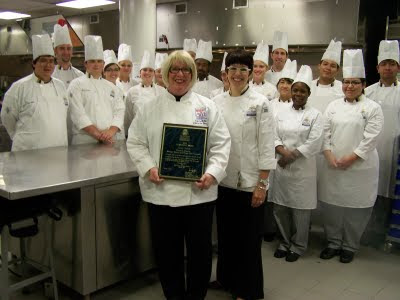Editor's note: A portion of the following Q&A was featured in the "A lifestyle in living cuisine" article (page 22) that appeared in the Spotlight department of the November 2009 issue of Chef Educator Today.
The highly anticipated
105degrees Academy opened its doors for the first time this September to welcome 10 students into the kitchens. But there won’t be aromas of braised meats, roasting vegetables or bubbling sauces drifting through the hallways. Instead, the students will learn the importance of seasonal produce at the peak of freshness and how to mimic textures of cooked food through techniques like dehydration, marinating, fermentation and puréeing. At the helm of this cutting-edge academy and adjacent café are partners Dara Prentice and Matthew Kenney. Kenney spent a few minutes talking to
CET about 105degrees and the philosophy of its founders.
 (bottom row, l to r) students Greg Loonie, Whitney Kear, Blake Schrick
(bottom row, l to r) students Greg Loonie, Whitney Kear, Blake Schrick(top row, l to r) student Jenifer Kuntz, student Hillary Coppock, student Sonja Bannon, academy director Ladan Raissi, student Michelle Corso, student Gina Harney and student Megan Massoth
CET: What are some of the foundations of raw food, and how are they different from or similar to the fundamental techniques of traditional cooking?
Kenney: Well, there aren't a lot of similarities between raw food and traditional cooking. But both share one requirement for excellence: the need for top-quality, seasonal ingredients at their peak--as ripe and local as possible, and organic where possible. That's something that they share. Techniques are entirely different because with a lot of cooking, you're transforming food--changing its texture through heat or charring or searing. You are also eliminating water through high temperatures. With raw food, you have to do that in a much more delicate way. We do that through the use of dehydrating or using various methods for creating crust or texture. We sometimes use raw ingredients for texture as opposed to cooking things until they're crispy; we'll use raw things that are already crispy. We use dehydrating, blending, marinating, something called thermal immersion cooking, which is low-temperature, underwater cooking in a sealed vacuum pack. We use something called an Anti-griddle, which is instant freezing. We use a lot of really cool techniques that aren't a part of traditional cooking. So it's a highly different set of skills resulting in a lot of similar flavors. But textures are a little different, temperatures are different and obviously enzymes in the flavor are different.
 Students working in the 105Degrees Academy kitchen
Students working in the 105Degrees Academy kitchenWhy did you select Oklahoma City as the location for the school?
Kenney: My partner [Dara Prentice] selected it. She's from here and knows the community well. She felt that there was a need not only for a restaurant here but also an educational facility. The demographics just made a lot of sense. Oklahoma City is a large city with a lot of interest in health, yoga and vegetarianism without really very many upscale options. It's also centrally located in the center of the country, so for educational purposes, that's very helpful. Like our first class, for example, we have students from both coasts. It's about being central. And we are in new development, and we love the architecture that would be very hard to find in a city like New York.
CET: How many students are enrolled?
Kenney: The classes only go up to 14 or 16 students total. The Level Two class can only hold eight, and the Level One class, which started in September, can only hold 14 to 16. And we already have about 10 for September, which is a couple more than we estimated, so we're pretty happy about that.
CET: Can you tell us a little more about how the curriculum was set up?
Kenney: Level One is a 20-day, four-week course. And that covers the fundamentals of raw cuisine. We want to teach basic fundamentals behind our philosophy--what we believe about raw food and certain terms on which things should be started and what to focus on in terms of ingredients. We're really going to focus on seasonality, taste, texture, presentation. And we're going to teach that through the more easy-to-understand dishes of our menu. The academy will always coincide with the menu in the café, meaning the curriculum will change every three months. So with Level One, students should have a really good fundamental understanding of raw food and how to prepare it, how to use all the equipment, how to understand ingredients and taste. And they'll learn a number of dishes as well. Level Two is a more advanced, professional course where we're going above and beyond. They'll learn how to actually work in a raw food kitchen, how to set up a station, design a kitchen. There's a lot more incorporated about wine, tabletop, the financial aspects behind running a raw food business, so it's a far more advanced level that takes three months.
CET: What are some of the greatest challenges you've faced as a raw food chef and one of the founders of the first living cuisine academy?
Kenney: Well, to be honest with you, I haven't felt that this project has been that challenging. It's challenging on a creative level because we want to be innovative and original in everything we do. In terms of it all coming together, everything has really flowed nicely since the beginning. We haven't really had any hiccups or any war stories. On the other hand, we are pushing ourselves to be highly unique. And every time you do that instead of falling into your comfort zone, there's a lot of experimenting required. So I'll try something that I think is going to be great, and it just doesn't work, so I go back to it three, four, five, six or even seven times. So you have to be very persistent.
CET: What would you say are the essential kitchen tools for the living cuisine chef?
Kenney: A sharp knife would be number-one. A really good blender is also important. We advocate using Vita-Mix, which I think is the only blender to use. A small dehydrator is helpful if you want to make crackers and pastries. And a good food processor, but it could even be one of those little Cuisinart Mini-preps. But a sharp knife, cutting board and blender or food processor are what you really need. It's not so equipment-intense as some people think.
 CET:
CET: It seems that you make a lot of purées with this type of cuisine.
Kenney: The reason there seem to be a lot of purées is that anytime something in traditional cooking would call for cheese or eggs or dairy or even flours--when you're baking, you're using flour, milk, eggs, butter--all things that have already been churned and pasteurized. So we're creating those ourselves. We make almond milk, we make milk from hemp seeds, from Brazil nuts and cashews. We make cheeses by fermenting nut purées. So in actuality, I think raw food has a lot more texture than cooked food. It definitely does. It just appears that there's a lot of puréeing going on because we're creating by hand these ingredients that everybody buys off the shelf. So people think it's a blender cuisine, but they couldn't be more wrong about it.
CET: Since raw food is heavily reliant on high-quality, seasonal ingredients, what is your strategy for securing the best ingredients year-round? Doesn't that get quite expensive?
Kenney: It is expensive to use the best ingredients. We work with as many local suppliers as we can that grow outside the city or travel to Texas a couple times a week to pick things up. We work with a local mushroom forager, and try to get micro-greens that are grown locally. So the closer you buy to home, the less expensive things typically are. That is actually part of the reason for buying seasonally as well--I mean, food is better and it's healthier if it's bought in season, but it's also more reasonably priced. If you buy raspberries in the middle of the winter, for example, they're very expensive. So actually, seasonality is part of our strategy to be able to afford those things.
CET: How did you get into a career in raw food?
Kenney: I was at a transitional point in my career. I had a number of restaurants in New York in the 1990s and early 2000s. After 2001, my companies really suffered. The economy was really poor, and I essentially lost everything--my company had to be dismantled and sold. I was in the process of figuring out how I wanted to start all over again, since I had been doing that for 15 years. And somebody introduced me to raw food. And I thought initially that it was a crazy idea, but when I tried it, it wasn't that the food I tried was great, it was that the way it made me feel was great. And the potential I saw was great. I thought, there's a much more interesting face in the marketplace for chefs to do something creative with healthy cuisine than for me to do another modernized American concept. It was also my personal passion. I loved the idea of being able to do something with healthier food and work around people who were more focused on that than indulging.
(photos courtesy of Meredith Baird)
 Robert Morris University (RMU) Institute of Culinary Arts students belonging to the school's service group Cooks for a Cause will bake 10,000 Christmas cookies on Dec. 4 and 5 to donate to The DuPage County People's Resource Center (PRC)'s Share the Spirit program. The PRC is gathering donations of new toys and gift certificates for more than 750 low-income families in DuPage County, which it will distribute in December. A pack of Christmas cookies from Cooks for a Cause will be included with all the gifts.
Robert Morris University (RMU) Institute of Culinary Arts students belonging to the school's service group Cooks for a Cause will bake 10,000 Christmas cookies on Dec. 4 and 5 to donate to The DuPage County People's Resource Center (PRC)'s Share the Spirit program. The PRC is gathering donations of new toys and gift certificates for more than 750 low-income families in DuPage County, which it will distribute in December. A pack of Christmas cookies from Cooks for a Cause will be included with all the gifts.


































